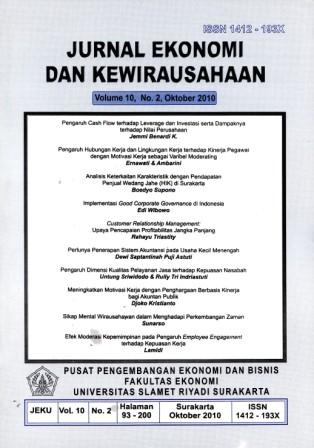PENGARUH CASH FLOW TERHADAP LEVERAGE DAN INVESTASI SERTA DAMPAKNYA TERHADAP NILAI PERUSAHAAN
Abstract
ABSTRACT
Indonesian economy has experience a great turbulence as an effect of financial crisis taking place in 1997 – 1998 which dragged the economic condition into severe, long term crisis. This crisis has destroyed the whole economic components including those in real sector and in the Indonesian capital market which causes many companies to go bankcrupt because of having financial distress. Therefore financial policy relating with financing and investment should be an important factor to attain the company goal.
This research is conducted at 100 go public manufacture sector companies in the Jakarta stock exchange as research sample in the period of 2000 – 2004, considering manufacture sector contribution is one third of the total economic output, performing the biggest product domestic bruto contribution, labor user, non oil sector provider, and sales to the whole sectors at Jakarta stock exchange covering more than 60%. Analysis technique implemented is structural equation modelling using AMOS 6 and SPSS 14 software.
Research results show that cash flow has a real impact upon leverage, investment, and firm value. If internal fund source of profitability is low and debt benefit is smaller than debt cost, the company will experience financial distress and risk of bankcruptcy. Therefore, the company is expected to be able to manage debt effectirely, conduct operational efficiency and effectivity, together with the use of too big debt while the macro economic condition has not been stable yet.
Keywords: Cash flow, leverage, investment, the value of firm.
Downloads
Published
Issue
Section
License
Authors who publish this journal agree to the following terms:
- Authors retain copyright and grant the journal right of first publication with the work simultaneously licensed under a Creative Commons Attribution License that allows others to share the work with an acknowledgement of the work's authorship and initial publication in this journal.
- Authors can separately make additional contractual arrangements for non-exclusive distribution published by the journal (e.g., publish it in a book), with an acknowledgement of its initial publication in this journal.
- Authors are allowed and encouraged to send their work via online (e.g., in the institutional repositories or their website) after published by the journal.









